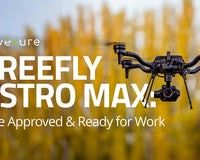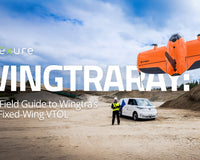First light breaks across central Kansas. In minutes, a compact quadcopter has traced a grid above 200 acres of soybeans. By the time the grower tops off his coffee, a color-coded NDVI map glows on his tablet, flagging an odd stress signature in the southwest corner—an early hint of root-feeding pests that looked invisible from the ground.
Traditional walking or ATV scouting touches only a fraction of a field and often misses these quiet warning signs. A single multispectral-equipped drone flight, on the other hand, captures every row, converts reflected near-infrared light into vegetation-health layers, and stitches them together on a laptop in the field. Kansas State University researchers note that drone scouting is both less labor-intensive and more thorough than conventional methods, giving growers a timely, data-driven edge. In one documented case, a 50-hectare wheat field was flown and fully processed in under 12 minutes with Pix4Dfields—quick enough to guide an in-season nitrogen pass before the sun climbed higher.
That’s the promise of targeted crop scouting with multispectral drones: seeing the unseen and acting before problems spread.
Why Traditional Scouting Sometimes Falls Short
Boots-on-the-ground scouting is still the gold standard for confirming what’s really happening in the canopy—but it struggles with scale and timing. A Penn State Extension study estimates that walking a 40-acre cornfield with the recommended “M” scouting pattern takes about 1.5 labor-hours, or roughly 27 acres per hour. On large operations that means multiple days—and multiple paid visits—before every corner is checked.
By comparison, a fixed-wing drone such as the senseFly eBee X can image 100 acres in 20 minutes (300 acres per hour) while capturing high-resolution NDVI data at the optimal growth stage. The difference isn’t just speed; aerial coverage delivers a complete field view, revealing early stress pockets that traditional scouting often miss. Ground truthing remains essential, but when drones pre-flag hotspots, farmers can walk straight to problem areas instead of spending hours hunting for them.
Multispectral Imaging 101
What “multispectral” really means.
Most crop cameras don’t just snap one color photo—they capture separate, narrow “bands” of light. A typical agriculture payload records at least five channels: Blue, Green, Red (~660 nm), Red-Edge (~715 nm), and Near-Infrared (NIR, ~840–850 nm). Healthy plants reflect substantially more NIR and absorb more red than stressed plants, so comparing those bands lets us spot trouble long before it’s visible.
NDVI: the workhorse vegetation index.
NDVI = (NIR – Red) / (NIR + Red)
The equation yields values between −1 and +1:
|
NDVI range |
Field meaning* |
|
< 0.1 |
bare soil / water |
|
0.2 – 0.4 |
sparse or stressed vegetation |
|
0.4 – 0.6 |
moderate canopy |
|
> 0.6 |
dense, vigorous crop |
*Ranges shift slightly by crop type and growth stage.
Beyond NDVI
-
NDRE = (NIR – Red-Edge)/(NIR + Red-Edge) – stays sensitive in dense canopies and is widely used for late-season nitrogen decisions.
-
GNDVI replaces the red band with green, tracking chlorophyll variation and offering better saturation tolerance than NDVI in lush crops.
-
MTCI, SAVI, MSAVI2 and others refine the signal for specific conditions like bare soils or high chlorophyll content.
Indexes turn invisible light into color-coded maps: dark greens flag healthy leaves, yellows or reds pinpoint emerging stress—from nutrient gaps to early pathogen activity—days or even weeks before the naked eye can tell something’s wrong.
A Step-by-Step Workflow: From Flight Plan to Actionable Map
Quick-start checklist. Seasoned agronomists can fine-tune the numbers, but these settings will get first-time drone adopters off the ground.
1. Plan the Mission
-
Altitude & ground-sampling distance (GSD)
-
Row crops: 260–400 ft AGL (80–120 m) → ≈ 1.2–4 in GSD (3–10 cm)—Enough detail for stand counts while still covering large blocks efficiently.
-
Orchards/vineyards: 400–500 ft AGL (120–150 m)
High enough to clear tall canopies and maintain uniform sun angles. -
Image overlap
-
Row crops → ≈ 80% front / 70% side.
-
Orchards → ≈ 70% front / 60% side.
-
Lighting window: Fly mid-morning or late-afternoon; avoid harsh noon shadows.
2. Fly the Grid
-
Load the polygon and overlap values into an autonomous flight-planning app (e.g., DJI Pilot 2, eMotion, Sentera FieldAgent).
-
Multirotor drones like the DJI Mavic 3 Multispectral can scan ≈ 500 ac (200 ha) on one 43-min battery, while fixed-wing systems such as the senseFly eBee Ag can image ≈ 1,235 ac (500 ha) in a single 90-min flight.
3. Process the Imagery
-
Drag-and-drop the photos into an ag-mapping package (PIX4Dfields, Solvi, DJI SmartFarm, Aeroview). The software auto-stitches an orthomosaic and calculates NDVI/NDRE layers in minutes—often on a laptop right at the field edge. (Section 8 compares these platforms.)
4. Interpret & Ground-Truth
-
Use the color-coded index map to flag low-vigor zones (e.g., NDVI < 0.4) or late-season nitrogen gaps (low NDRE).
-
Walk, drive, or ATV straight to those GPS-tagged spots for leaf pulls, pest counts, or soil tests—saving hours of blind scouting.
5. Act on the Insights
-
Export prescription shapefiles to a variable-rate sprayer or apply spot treatments immediately.
-
Archive each flight to track seasonal trends and validate input ROI.
6. Regulatory Reminder
-
Under FAA Part 107 (or your regional equivalent) stay ≤ 400 ft AGL, and maintain visual line of sight, unless you hold a waiver.
Real-World Benefits & ROI
Targeted input savings
Louisiana SARE trials showed that cotton achieved the same 1,288 lb ac-¹ yield while using 50% less nitrogen (15 lb ac-¹ vs 30 lb ac-¹) when prescriptions were built from multispectral drone maps. Corn plots hit peak yield (226 bu ac-¹) with 10-17% less N (99-108 lb ac-¹ vs 119 lb ac-¹). Cutting inputs without hurting yield protects both profit margins and waterways.
Time & labor efficiency
A fixed-wing senseFly eBee X can image up to 1,235 ac (500 ha) in a single 90-minute flight, slashing field-time compared with walking transects. Growers who self-fly typically spend $10–15 ac-¹ for seasonal imagery, while outsourcing full-season scouting can run as high as $70 ac-¹. Owning the workflow pays off quickly on operations that need frequent passes.
Yield protection through earlier action
UNH researchers documented that drone-based multispectral surveys detected fungal disease pressure in Brown-Midrib corn weeks before symptoms were visible at ground level, giving farmers a wider treatment window and helping avoid late-season yield losses.
Environmental stewardship
Variable-rate applications driven by drone maps not only save money—they also reduce nitrogen runoff, a key goal for sustainability programs along major watersheds.
Use-Case Snapshots
1. Nitrogen fine-tuning in corn
Mid-season NDRE maps routinely uncover subtle N variability across large pivots. By exporting a prescription shapefile to a variable-rate side-dress rig, growers can cut expensive urea in low-need zones while boosting deficient areas—often shaving double-digit pounds of N per acre without sacrificing yield.
2. Early pest pressure in soybeans
Bean leaf beetles and aphids leave only whispers of canopy stress at first, but multispectral data registers those pockets as faint yellow dips in NDVI long before defoliation is visible. Targeted scouting teams can treat just a few hot spots instead of spraying the whole field.
3. Drought streak detection in winter wheat
GNDVI imagery taken two weeks after top-dress highlights moisture-starved streaks caused by uneven irrigation pivots. By correcting nozzle flow only where GNDVI falls below 0.45, operators restore uniform tillering and prevent thin heads in the combine pass.
4. Emitter clogs in almond orchards
Tree crops hide water issues beneath dense canopy. Drone flights at 120 m AGL display instant NDVI depressions where micro-emitters are clogged. Maintenance crews can replace emitters tree-by-tree instead of flushing an entire block—saving labor and thousands of gallons of water.
5. Block-specific harvesting in vineyards
Near-harvest NDVI zoning segments a vineyard into high-, medium-, and low-vigour blocks. Winemakers pick lighter-canopy sections early to lock in acidity, then let lush zones hang for phenolic development—delivering more consistent flavor profiles without blanket harvest dates.
Top Multispectral Drone Platforms
DJI Mavic 3 Multispectral
-
Imaging payload: 20 MP 4/3 RGB + four 5 MP multispectral bands—G 560 nm, R 650 nm, RE 730 nm, NIR 860 nm, plus sunlight sensor for on-board radiometric correction.
-
Performance: up to 43 min endurance; a single battery can map ≈ 200 ha (494 ac) at 120 m AGL.
-
Precision: clip-on RTK module delivers ≈ 2 cm XY accuracy without GCPs.
-
Best For: best for small- to midsize farms and mixed orchards needing a one-person, toss-in-the-truck solution.
DJI Matrice 350/400 RTK + AgEagle MicaSense RedEdge-P
-
Airframe: 55 min flight time, IP55 weather-sealed, 2.7 kg max payload, accommodates triple-gimbal stacks.
-
Sensor: RedEdge-P captures five calibrated narrow bands + 5 MP panchromatic, delivering 2 cm GSD at 60 m and enabling pan-sharpened, research-grade outputs.
-
Precision: integrated dual-antenna RTK/PPK achieves sub-centimeter horizontal accuracy.
-
Best For: ideal for large acreages, co-ops, or agronomy firms that need heavy-lift flexibility (multispectral today, LiDAR tomorrow) and survey-grade data.
Inspired Flight IF800 TOMCAT + RedEdge-P
-
Airframe: U.S.-made, foldable; 54 min max flight and 3 kg payload capacity; 23 kn wind resistance.
-
Precision: optional NAV RTK base unlocks centimeter-level mapping; dual GPS modules support PPK workflows.
-
Operational perks: hot-swappable batteries, upward-angle camera mount, Blue-UAS listing for federal projects.
-
Best For: producers or agencies requiring U.S.-origin hardware, long endurance with heavier sensors, or compliance with federal procurement rules.
senseFly eBee Ag (fixed-wing)
-
Endurance & coverage: up to 55 min per flight; maps ≈ 500 ha (1,235 ac) at 120 m AGL with endurance battery.
-
Sensor: Duet M dual payload—20 MP RGB + four-band multispectral (G 560 nm, R 660 nm, RE 735 nm, NIR 790 nm).
-
Precision: optional RTK achieves ≤ 2.5 cm absolute horizontal accuracy.
-
Best For: agronomy consultants and research teams covering hundreds of acres per sortie who value hand-launch simplicity and low operational noise.
Software: Turning Pixels into Prescriptions
Below are four three ag-mapping platforms that convert raw drone imagery into actionable, machine-friendly prescriptions. Pick the ecosystem that matches your connectivity, analytics, and equipment needs.
Pix4Dfields
Offline speed for in-field decisions
-
Processes multispectral imagery on a laptop in minutes, no internet required.
-
Auto-generates NDVI, NDRE and custom indexes, plus zonation and variable-rate shapefiles for most controllers.
-
Season-long project management for trend analysis.
Solvi
Cloud analytics for whole-farm management
-
Uploads flights; returns index maps and elevation layers in 30–60 min.
-
Builds management zones, 1m-resolution prescription files, and sharable web links.
-
Field-trial module calculates plot-level metrics for research blocks.
Aerobotics Aeroview
Tree-level orchard intelligence
-
AI detects pest or disease hotspots and scores individual trees on vigor.
-
Generates block maps, performance rankings, and season-end yield estimates.
-
Integrates directly with DJI Mavic 3 Multispectral for streamlined data capture.
From Data to Decisions
Multispectral drones give growers a field-wide, pixel-level view that traditional scouting simply can’t match. NDVI and related indexes turn reflected light into early warnings for nutrient gaps, pest flare-ups, and water stress—insights that guide targeted treatments rather than blanket applications. The workflow is straightforward: plan the mission, fly the grid, process the imagery, ground-truth, and act.
Whether you’re covering a 160-acre corn pivot with a multirotor or a 1,000-acre orchard block with a fixed-wing, the payoff is the same: less time in the field, fewer wasted inputs, and healthier, more uniform crops.
Advexure’s ag-tech team leverages years of precision-ag experience to match growers with the right UAS solution. Reach out to our team today!










